Fonseca vs ADF: Basel Final Recap
the signal in misses — fate and forehand setups — physical development timelines
Joao Fonseca defeated Alejandro Davidovich Fokina in the final of the Swiss Indoors ATP 500 on Sunday to clinch his second title of the year (Argentina Open). The win also catapults the teen into the top 25 of the ATP race to Turin.
This match was one-way traffic from the very first point when Fonseca hit a serve and +1 forehand winner. Known for a degree of bludgeoning power that defies his puppy physique and face, Fonseca has always shown interest in the finer parts of the game — blocked returns, backhand slice, drop shots and volleys — and put them to good use early on:
Back when I first wrote about Fonseca, I gushed over the forehand of course, but also pointed out that the tour had seen plenty of dangerous forehands in the last 10 years (Tsitsipas, Berrettini, Rublev, FAA, Ruud, Dimitrov, etc.,) who nevertheless failed to dent the grand slam hopes of the establishment, largely because their backhands were not cut from the same cloth.
Fonseca, despite below average backhand ratings in 2025, will have a backhand that can hang with the best. He has always had the ability to go both ways with that shot, and despite the youngster missing often, I’ve always contended that there is signal in missing; data ignores it, but the eye test does not.
Those who got to bear witness knew way back in Australia:
Yoshihito Nishioka: “Fonseca is so amazing. This level of perfection is so amazing. He will definitely win the tour this year. He will finish in the top 30. This is the ultimate example of modern tennis. Almost all of the balls he hit were better than Rublev’s.”
Darren Cahill: “I asked Jannik [Sinner] what ranking he thought João Fonseca would be at the end of the year and he replied ‘in the top-25’.”
The 2-0 game was a good example of Fonseca’s undeniable quality, despite finding himself in a hole at 30-40 break point:
On the first point he drilled an approach backhand down the middle just long. This is the kind of miss that dents the scorecard but not the belief.
At 0-15 he hit a poorly placed body serve serve at 217 km/h that ADF replied brilliantly with a deep backhand and Fonseca was late to the reply, catching the tape and wide on his own backhand. A good example of the puppy legs in action.
at 0-30 he hit a 227km/h tee ace. That’s 141 in old money.
At 15-30 he hit a T-slider and played two forehands to conservative areas using swings that are anything but: the legs and hips driving his upper body hard enough to turn his On playing shirt into a midriff:
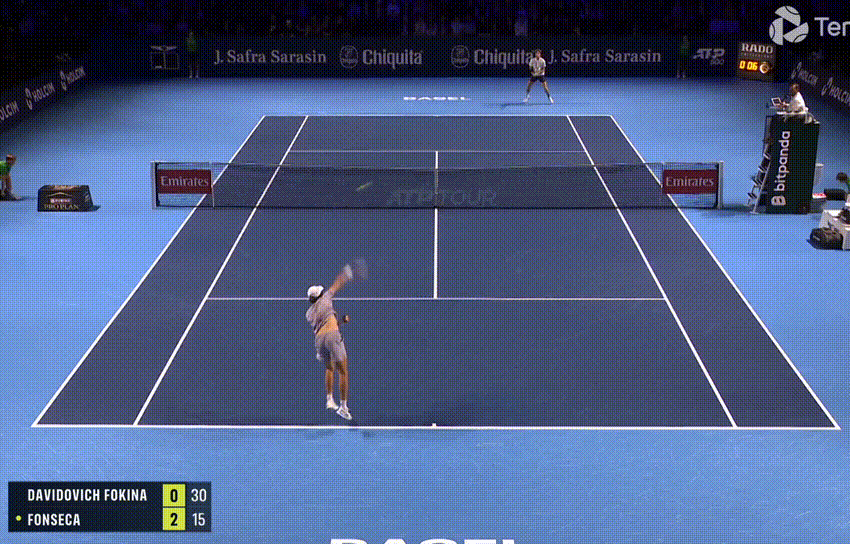
At 30-30 he missed an approach shot into the net. Freshman point for sure.
At 30-40 (break point) he hit 232 out wide. 144 mph. Not coming back.
Deuce and he doesn’t hit his spot and hits a weak plus one from neutral which Fokina crushes for a winner. Worst point of the game, but credit to Foki here more than anything.
Ad-receiver: 227km/h out wide. Swing volley forehand plus one winner.
Deuce 2: 226 km/h down the T
Ad-server: 227km/h down the T.
Fokina played a very solid/aggressive return game and came up empty through no fault of his own.
A point is a point in tennis. But as a developing youngster, the way he is losing and winning points suggests greater profits are on the horizon, that even with all the wins now, more is coming, after the peonage of being an inexperienced big-hitter has passed.
Tennis TV comms:
“What I think he is, is that modern player. It’s: see ball, crush ball.”
“Does he need more than that thought?”
“Yep, definitely, but at 19, you got to feel that that will come.”
And as I’ve said, Fonseca is constantly playing with more than that.
I thought this was a pretty good drop shot — Fokina was recovering hard left/back and Fonseca played it in behind him — but the Spaniard has a quick set of wheels:

Tennis Insights had Fonseca playing 23.7% of points with variation in this final (the tour average is 19.1%, and Fonseca’s 52-week average is 21.2%1), which is a promising sign; it must be tempting to the teenaged mind to simply try and blast your way through players when you own that much artillery. Even Jannik Sinner — a decent player comp for Fonseca — is now working on adding in variation, despite owning the tour’s premier power-baseline game.
Fokina broke in that game but the Brazilian got right back to work, breaking again after the changeover with more damaging return +1’s like this:
Fokina’s serve is below average by tour standards, and Fonseca capitalised on that, consistently returning balls deep and hard to give himself return +1’s. Gill Gross had advanced insights to point out that even Fokina’s first serve was getting minced, with Fonseca returning deep 39% of the time (tour average: 29%).

On second serve returns, we also saw that Fonseca had a clear plan to attack the Fokina forehand:
The Fokina forehand is the clear weaker wing, especially as he owns one of the most technically compact double-handers in the business.
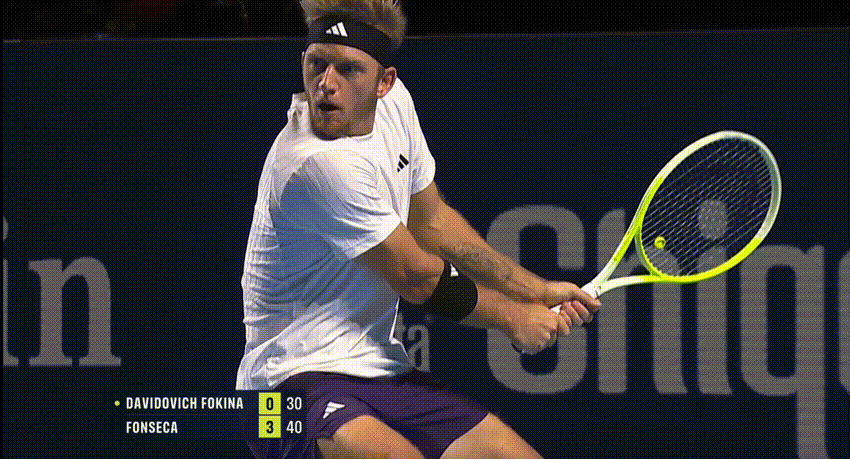
But back to the forehand for a small technical digression.
Fokina’s forehand looks technically pretty clean in terms of pieces; there’s nothing eye-catching that stands out of his compact stroke, but I believe he creates a weaker stretch in his chest and arm muscles (he isn’t the most elastic athlete by appearances; more strength than stretch) and is guilty of sometimes ‘placing’ the racquet below the ball before accelerating.
Compare how late Fonseca’s racquet gets below the ball on comparable set pieces:
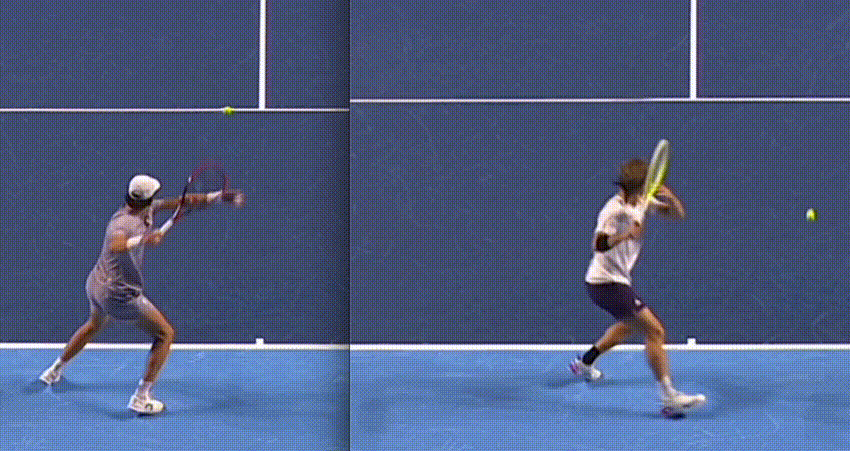
A clearer view of Fonseca:
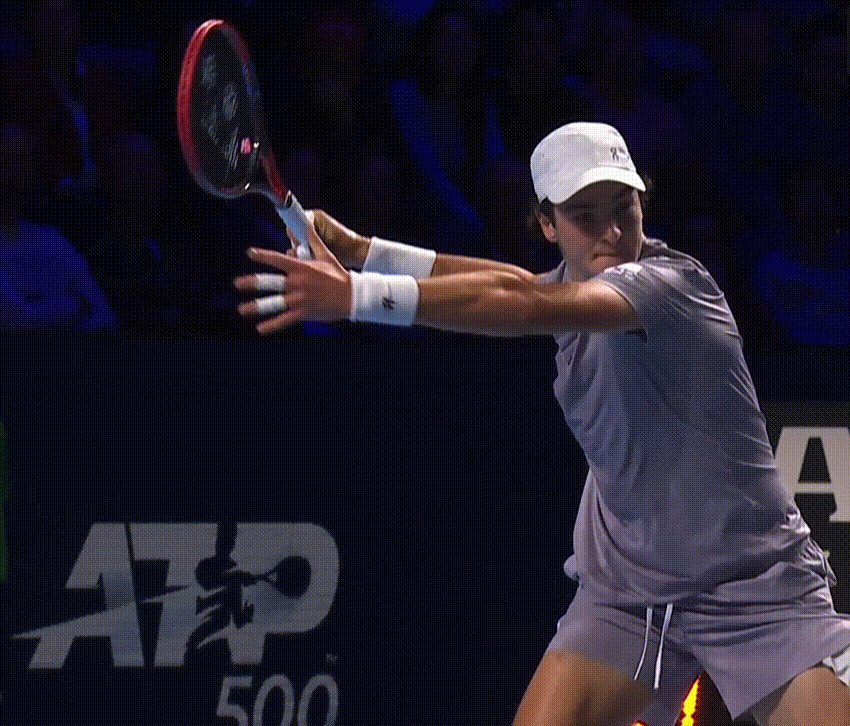
Said another way, there are all these different positions a racquet assumes along a swing path from the setup to the hand/racquet drop to the slot position and into contact. Fokina’s racquet kind of visits the racquet drop area and hangs out momentarily before getting pulled through for the slot position. Joao’s racquet doesn’t see shit: it suffers from severe whiplash from setup to contact.2
I wrote something similar when comparing Mensik’s forehand to Fonseca’s after the Czech’s Miami Masters win:
“This is what a gravity versus non-gravity forehand looks like, and there is no way to make up for such a deficit. It’s like racing your friend on a push bike, but they get a rolling start off a hill.”
Of course talent and raw athletic ability count for most of a player’s potential, but I believe these small technical differences are often the decisive factor that create divergent fates in shots (and therefore titles/careers). ADF’s will always be susceptible. Fonseca’s will always be dangerous.
Pro tennis is largely a backswing game.
But much of the criticism of Fonseca has been about his movement. An old coach of mine used to bark an aphorism as we were put through some punishing side-to-side drills: “the legs feed the wolf”. It was a reminder that no matter how big the teeth, it was the footwork that earns the meal. Big shots are useless without balance and positioning.
Pro tennis is largely a movement game.
Fonseca is never going to be an Alcaraz or de Minaur mover, but it’s been crazy to follow social media’s knee-jerk reactions after a loss given his tender age and lack of physical development. It was only last year that Fritz was saying how much faster Sinner had gotten out of the corners since their first meeting:
“The serve and the movement. Massive improvements. [In 2021] I could find myself in a lot of return games just off of his first serve. I felt I could get myself in points off his first serve every time. And back then, it was much easier to hurt him from the ground as well. He’s much faster, a lot better out of the corners.”
- Fritz on Sinner’s improvements since their first match in 2021
That was comparing a 23-year-old Sinner with a 20-year-old Sinner. The various improvements made after his teenage years.
We are still a long way from knowing Fonseca’s physical potential.
For now, the tour still has to contend with some pretty big teeth:
Fonseca won his first round in Paris, defeating Denis Shapovalov in a tough three-setter. He plays Karen Khachanov in round 2.
I’ll see you in the comments. HC.
For comparison, Alcaraz is ~29% variation, and the tour leaders are backhand-slice-heavy players:
Federer and Nadal late in their careers took on a kind of deliberate racquet drop, probably because of the speed of the game, but I always felt their forehands were better with more leverage.





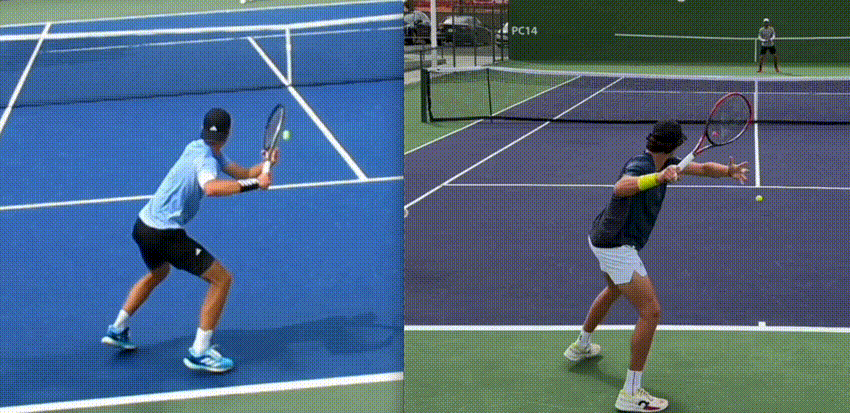
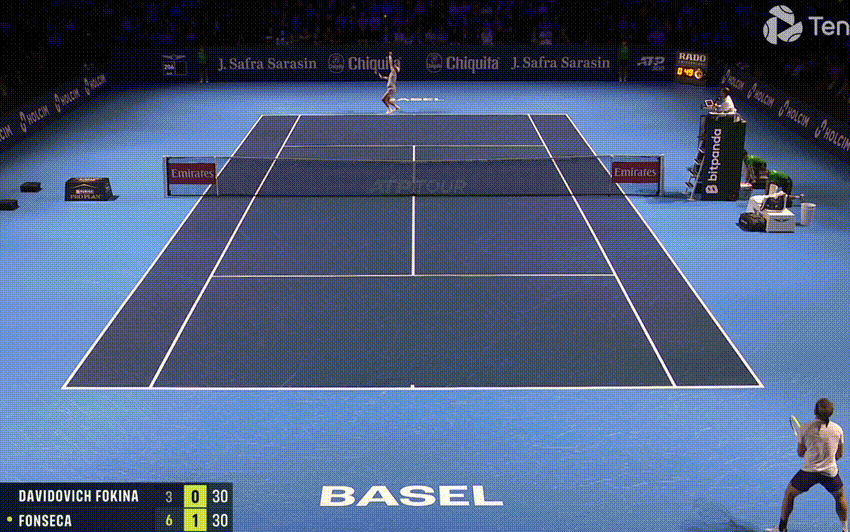

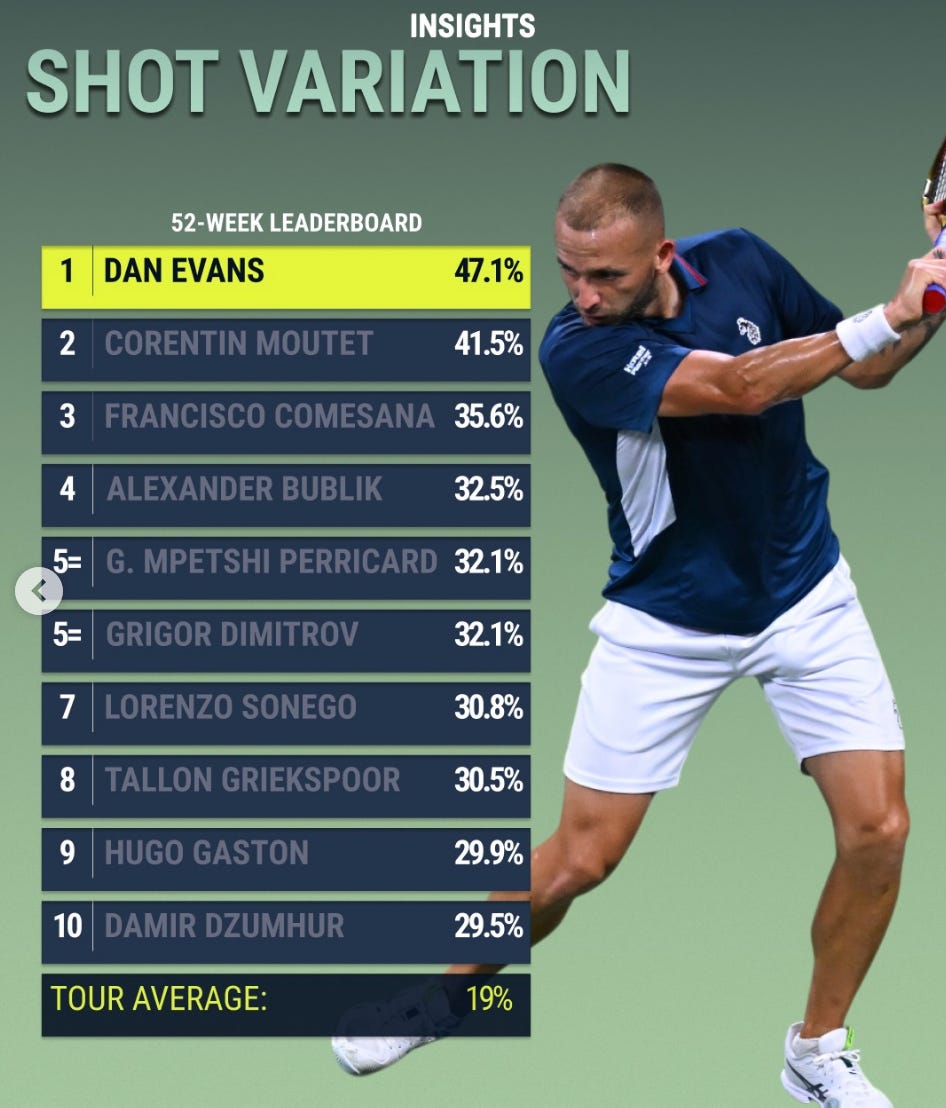
Hi Hugh,
A great analysis as always, and it's always fascinating to read you go into the depths of technique.
An observation regarding Fonseca's physical development : while I agree he isn't in his prime yet, I tend to think that you can see special athleticism early, and that physical improvements are only small (and mainly stamina-related rather than movement/explosiveness/reactions). Things like return stats tend to peak early. In fact, if you take young Sinner (19 to match with Joao) as an example since you mentionned him, he was already winning 40.8% of return points (2020). 2025 Fonseca is at 36.7, which is slightly below Top 50 Average. Obviously he's never going to be an elite mover as you said, but if he is to fight for the biggest silverware in the sport, he may need to be.
What role does Fonseca’s extended racket play in your eyes? Seems to be a very double edged sword. Major power clearly but I wonder if he needs that - so much harder to play defense when the bullets are flying at high levels.